Dive Into Our History
Since the start of commerce by sea, vessels and their crews have tragically come to grief along this treacherous coastline. Locals in the distant past were often only interested in saving the cargos from ship wrecks rather than the lives of mariners. During the 1800s people’s attitudes were changing and rescue and saving of life was deemed the correct and Christian thing to do. The newly formed charity the Royal National Lifeboat Institution allocated a lifeboat to the developing port and town of Porthcawl. Prior to this, rescue had been carried out by local boat men and crews of other vessels.
The local wealthy land owners the Knight family and business man William Weston Young individually had their own schemes for rescue of those in grave and imminent danger prior to the formation of the lifeboat service. The Reverend Knight put in place a device called a Manby mortar to fire a rescue line out to ships and Mr. Young was willing to put out to sea with local boat men to aid stricken vessels but some of his efforts gained him the title of looter and wrecker

1860 - 1872 'THE GOOD DELIVERANCE'
‘Good Deliverance’ was a 30ft pulling & sailing lifeboat it had six oars and a crew of nine.
The lifeboat was launched on a large wooden wheeled trolley with the aid of farm horses and man power, launching directly into the sea. The Promenade as we know it was not built until some time later. There was only a slope down to the shore line and often the lifeboat would be drawn by horse to a suitable launch site as near to the casualty vessel as possible.
In November 1865 the lifeboat’s service was required when the Portuguese brigantine Argo was inbound from Fayel and found it’s self in difficulties at Tusker Rock in a strong south westerly gale. She was abandoned by her crew and after one failed attempt the lifeboat Good Deliverance saved the vessel.
Again on 24th May 1866 an unknown French lugger was seen in difficulties on the Scarweather Sands the life boat launched but was unable to get near the stricken vessel and it broke up with the loss of all hands. The lugger’s name was never discovered.
On 5th December 1869 The Spanish schooner Loretta was wrecked on the Nash Sands. The Porthcawl life boat battled to the scene and saved the Captains wife, the pilot and eleven of the crew.
During the night of 17th December 1870 the Cardiff pilot cutter the Dasher foundered on the Tusker Rock, the lifeboat went to its aid and saved the pilot and the vessels crew of three.
The lifeboat, The Good Deliverance, was stationed in the town for 12 years and launched on seventeen rescues and saved 26 lives.
1872 - 1887 'THE CHAFYN GROVE'
When the current lifeboat station was being built a scale model of the Chafyn Grove was discovered in storage at RNLI Head Quarters in Poole.
This model would have been built by apprentices in the ship yard when the lifeboat was originally constructed and presented to the donor of the boat. In this case it was Miss Grove of Zeal of Wiltshire who was a well known philanthropist at the time. The model is now on display within the new station.
Improvements are common place within the RNLI and even in the distant past this was true. In 1873 a roadway was built to the east of the station to assist launching into Porthcawl Creek, now the harbour. During Chafyn Grove’s service at Porthcawl the lifeboat launched eight times and saved 28 lives.
In 1878 the RNLI improved their launching facilities further with the construction of the slip way alongside the pier and to this day it is still the primary launch site for Porthcawl lifeboat. Although it was altered during war time by the military when the Jennings Building Saw Mill was turned into a base for the RAF air sea rescue launches which were moored in the harbour.
1887 - 1902 'SPEEDWELL'

With much pomp and ceremony, a new lifeboat arrived at Porthcawl in 1887. This was brought into the town by the GWR Rail Company at no charge and craned off at the town’s new railway station. Speedwell was a 34ft pulling and sailing lifeboat with 10 oars and a crew of 13. During its service at Porthcawl, Speedwell launched on nine rescues and is stated to have saved two lives. The Pearce family who were ship’s pilots served on the lifeboat as crew and coxswain. Descendants of the family are still living in the town today.
Speedwells’ service for the RNLI did not end there; she spent the rest of her days at Scarborough on the north east coast of Great Britain, saving eleven lives in one rescue.
By now the larger ports of Swansea, Penarth and Barry had opened and with the dangers of Tusker Rock and our local offshore sand banks, along with the then efficient rail network, exporting of coal from the small docks here at Porthcawl became untenable. In 1902 the port closed and soon after the RNLI removed the lifeboat from this station. The old boathouse still exists on the Esplanade and at the time of writing is currently an Indian Restaurant.
The speedwell Lifeboat was stationed at Porthcawl between 1887 and 1902. It was a 34ft pulling and sailing with 10 oars and a crew of 13 and during its time in porthcawl, saved two lives.
1902 - 1965
The ‘Inner’ harbour was used as a graving dock until the mid 1920s when some destroyers were scrapped by Hayes metal merchants of Bridgend. It was then used as a boating lake and swimming area. During the 1930s it was filled in with colliery waste and since those days has been a car park.
The ‘Outer’ harbour was used, as it is today, by a small number of inshore commercial fishing boats and pleasure craft.
In December 1946 the diesel electric tanker the Tillamook dragged her anchors in Swansea Bay and ended up washed up on the beach at Sker Point, a little under three miles north west of Porthcawl pier. She was finally towed off in the March of 1947. Only one month later a tragic loss of life took place only a few hundred yards to the south east when the liberty ship SS Samtampa was driven ashore onto the end of Sker Point in a violent gale with all hands being lost. The Mumbles lifeboat had battled 11 miles across the bay in what witnesses say was the most horrendous storm in living memory. Unfortunately the Mumbles lifeboats’ valiant attempt to save the stricken steam ship crew also ended in tragedy with the loss of the lifeboat and all her crew. The upturned lifeboat was dashed on the rocks only a few yards east from the ship that the storm had torn into three parts.
The war years saw the Royal Air Force arrive with their high speed rescue launches. Based in the Jennings buildings they stayed until the early 1960s. Many of the crews settled in the town after their military service and the lines of sleek launches moored in the harbour are fixed in the memories of older residents and visitors to the town.
Lifeboat Re-establishment
It was in 1965 that the RNLI returned to Porthcawl and stationed one of the new experimental inshore lifeboats. Based on a 16ft inflatable it was designated as the ‘D’ class inshore lifeboat. Adverts were placed in the town and a meeting held to organise a station and crew. As with all lifeboat crews, they came from all walks of life and had one common goal, an interest in the sea and the will to help others.
Inshore lifeboats
With people having more leisure time and the number of visitors coming to the coast increasing, more people were getting into difficulties in the sea. The inshore craft was designed to give rapid response to people and small craft using the sea and coastline for recreational purposes. With the increase in personal transport and the railway station at Porthcawl, thousands of day trippers travelled directly into town. People would come and camp on the areas of sand dunes that border the area and this swelled the population of the then small dormitory town.
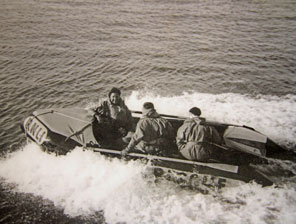
There was no care for the environment in those days so hundreds of acres of sand dunes were bulldozed and the sand sold to the construction industry, the leveled land was then turned into what was in its heyday, during the late sixties and seventies, the largest caravan site in Europe at Trecco Bay.
Porthcawl’s new lifeboat operated in the area from Nash Point in the east to the river Kenfig in the west, a distance of approximately 16 miles. This boat was housed in a building alongside the Jennings buildings just across the way from the present station doors. Adverts were placed locally and a 14 man crew was selected from those who applied.
The lifeboat covered the summer period from April until September during the hours of daylight and in sea conditions up to force 5 [25mph wind speed]
This type of lifeboat was a great success; these small versatile craft are now without doubt the mainstay of the RNLI fleet. Its boathouse was modified many times and four of these lifeboats were stationed here at Porthcawl until the construction of the new boat house to accommodate the larger Atlantic class lifeboat.
1965 - 1970 D CLASS 52
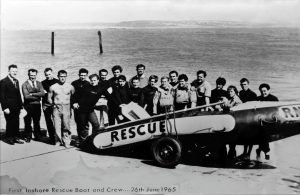 This lifeboat was funded by the ladies guild of Hereford, a 16ft inflatable lifeboat manufactured by RFD and launched by man power. The first of these inshore lifeboats carried the most rudimentary equipment but it served its purpose, to aid swimmers and water users in difficulty. This carried on for a number of years until better equipment was developed and the boats had reliable communication with the shore and coastguards.
This lifeboat was funded by the ladies guild of Hereford, a 16ft inflatable lifeboat manufactured by RFD and launched by man power. The first of these inshore lifeboats carried the most rudimentary equipment but it served its purpose, to aid swimmers and water users in difficulty. This carried on for a number of years until better equipment was developed and the boats had reliable communication with the shore and coastguards.
One of the first rescues carried by this boat was to the aid of a swimmer in difficulties; the incident was reported by a beach lifeguard who was also one of our newly formed crew. He sprinted across the beach from the lifeguard station and was crew on the lifeboat that carried out the rescue he had reported. His son and two grandsons have also served with the station. In total eight members of the one family have served at the Porthcawl lifeboat station since its reopening in 1965. Seven members of another extended family have also served continuously since the first member joined the crew.
The inshore lifeboat also assisted The Mumbles lifeboat in her rescue of the crew of the sand dredger Steepholm on the 3rd October 1968, which ran aground on the Tusker Rock 2 miles ESE of the station. The hull of the Steepholm was torn apart and foundering on the rock. A joint effort by both the all weather Mumbles lifeboat and the inshore Porthcawl craft ensured the safety of the ships crew. Three of the crew from Porthcawl were commended for their efforts in this rescue. The coxswain of the Mumbles lifeboat Mr. Derek Scott was awarded the RNLI Bronze medal.
Three days later the lifeboat was called out again to the Steepholm, this time to assist a group of local sightseers who had visited the stranded ship. A sudden change in the weather made it impossible for the small craft they used to get the souvenir hunters off the ship wreck. The Porthcawl crew also had recognition for this rescue that undoubtedly resulted in the saving of lives.
1970 - 1983 D CLASS 174
 This lifeboat was stationed at Porthcawl from 1970 until 1983; this craft was also manufactured by the British company RFD. As the dates show this lifeboat was stationed here for 13 years and carried out many rescues, far too many to mention. Many of the people that were helped by this and other boats are glad of the assistance given in their time of need.
This lifeboat was stationed at Porthcawl from 1970 until 1983; this craft was also manufactured by the British company RFD. As the dates show this lifeboat was stationed here for 13 years and carried out many rescues, far too many to mention. Many of the people that were helped by this and other boats are glad of the assistance given in their time of need.1983 - 1989 D CLASS 291 'DONALD RIGBY MIDDLETON'
 ‘Donald Rigby Middleton’, was a 16ft long ‘D class’ inshore lifeboat and was manufactured by RFD. Each year the number of call outs increased and countless numbers of people owe their thanks to the crews that aided them when needed.
‘Donald Rigby Middleton’, was a 16ft long ‘D class’ inshore lifeboat and was manufactured by RFD. Each year the number of call outs increased and countless numbers of people owe their thanks to the crews that aided them when needed.
One of the most interesting rescues was carried out during a training exercise with the Royal Air Force helicopter on a cold winter’s morning. The winch man had been dropped in to our ‘D class’ lifeboat and was briefing the crew when a man who was fishing fell off Porthcawl pier. He was spotted by the helicopter, but minus the winch man they could not assist. Contact was made with our lifeboat and it was on scene within seconds. Crew man Wayne Evans jumped into the icy water and grabbed the casualty just as he was slipping under water. He was rushed ashore and following hospital treatment he made a full recovery.
1989 - 1996 D CLASS 390 'TIGER D'
1996 - 2009 ATLANTIC 75 B CLASS B726 'GILES'
 Around this time, much work had been going on in the back ground. The crew was split into two groups and sent to the RNLI training facility at Cowes on the Isle of Wight. Here each group spent one week of intensive training learning how to man an Atlantic 75 lifeboat that was soon to be stationed in their town.
Around this time, much work had been going on in the back ground. The crew was split into two groups and sent to the RNLI training facility at Cowes on the Isle of Wight. Here each group spent one week of intensive training learning how to man an Atlantic 75 lifeboat that was soon to be stationed in their town.
January 1996 saw the completion of the purpose built lifeboat station to house the latest Atlantic class lifeboat. The relief lifeboat Atlantic 21 ‘Blenwatch’ was stationed at the town, while the Atlantic 75 lifeboat ‘Giles’, named after the famous Daily Express cartoonist Carl Giles, was constructed. ‘Giles’ was placed on station and its naming ceremony took place in October 1996. This craft had a top speed of over thirty knots and could operate both day and night in conditions up to force seven.
The new station soon became Wales’s premier inshore lifeboat station and boasted the first female crew member to become a helmsman in Wales.
It was one stormy winter’s morning on 2 February 2002, when a call came in that a man fishing off Porthcawl Breakwater, only yards from the station had been washed into the water. Luckily this was observed by the local harbour master Mr Les Pearce, a relative of the last coxswain of the ‘Speedwell’ lifeboat.
Nick Beale a trawler skipper and fish and chip shop owner, helmed the lifeboat and carried out one of the most amazing rescues ever seen at Porthcawl. The rescue was seen by a large crowd ashore and fortunately, against all the odds in such conditions, the casualty was recovered from the sea and survived after being resuscitated by crew members and then by the attendant ambulance crew.
For this meritorious rescue Nick Beale was awarded the RNLI bronze medal. Also on the lifeboat that day were Steve Knipe and Ricardo Rava.
24|08|2004 - Gower Pride Rescue
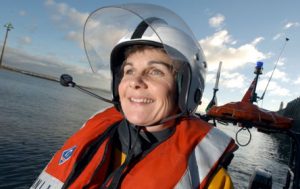
Aileen Jones helmed the lifeboat on an other meritous rescue when ‘Giles’ was tasked to the aid of the fishing vessel ‘Gower Pride’ .The vessel had suffered engine failure and the skipper had deployed two anchors but neither would stop him drifting on to the dangerous Nash Sand banks.
One of the ‘Gower Pride’ crew men on board the fishing vessel had injured himself in an attempt to anchor the drifting vessel. The life boat arrived on scene in a three metre swell with a wind force of seven on the Beaufort scale. A tow was passed to the fishing vessel, but it soon parted due to the sea conditions. It was then decided to place a lifeboat crew man onboard the fishing vessel, the tow was reconnected and the slow tow was then carried out back to Porthcawl. After some time, extra assistance was given when the all weather ‘Mumbles’ lifeboat arrived and took over the tow returning the disabled fishing boat to her home port of Porthcawl. Meanwhile the Porthcawl lifeboat sped the injured fisherman ashore to an awaiting ambulance crew. For this rescue Aileen Jones was awarded the RNLI Bronze Medal and the crew given ‘Framed Letters of Thanks’.
Aileen Jones (pictured) was the first female crew member in 116 years to be awarded a Bronze medal for gallantry
2009 ATLANTIC 85 B CLASS B832 ‘ROSE OF THE SHIRES’
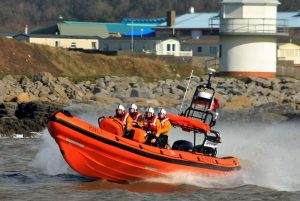 Delivered in May 2009 this lifeboat soon started her vital work in the Bristol Channel in October of this year the lifeboat was named in a ceremony involving hundred of guests and an equal number of onlookers. We were gifted with a bright sunny afternoon with many of the guests travelling long distances from the Northampton area where most of the fundraising for this craft took place.
Delivered in May 2009 this lifeboat soon started her vital work in the Bristol Channel in October of this year the lifeboat was named in a ceremony involving hundred of guests and an equal number of onlookers. We were gifted with a bright sunny afternoon with many of the guests travelling long distances from the Northampton area where most of the fundraising for this craft took place.
Rose of the Shires has saved numerous lives in the time she has been stationed in Porthcawl. More recently in December 2015 the life of fisherman was saved after he had been swept from the breakwater at Porthcawl.
2012 D Class (IB1) D714 'JEAN RYALL'
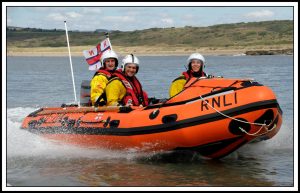 A D Class was placed on service at Porthcawl in 2012 as it had become apparent that whilst the Atlantic 85 was proving a valuable asset it couldn’t operate close inshore which was often a requirement in the callouts we were responding to. A service of rededication was held at Porthcawl as the boat had previously served at South Broads.
A D Class was placed on service at Porthcawl in 2012 as it had become apparent that whilst the Atlantic 85 was proving a valuable asset it couldn’t operate close inshore which was often a requirement in the callouts we were responding to. A service of rededication was held at Porthcawl as the boat had previously served at South Broads.2013 Porthcawl Volunteers Awarded RNLI Bronze Medallion for Flood Rescue
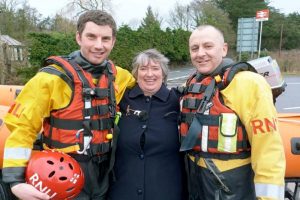
Porthcawl volunteers Chris Missen and Paul Eastment were both awarded the RNLI Bronze Medal for a rescue as part of the RNLI Flood Rescue Team. During December 2012 many parts of the UK had been badly affected by flooding. Members of the RNLI Flood Rescue Team had been sent to Devon and on the night of 23rd December news came in that a woman had been swept from her car and into the flooded and fast flowing river at Umberleigh. Casualty, Vanessa Glover, was reported to have been heard in the darkness calling for help, she had fortunately managed to cling onto an overhanging branch.
With other rescue services unable to help Mrs Glover the RNLI team made the decision, at 1.51am to launch their rescue craft into the flooded river. In the darkness the team eventually located the casualty and managed to bundle her into the rescue boat whilst fighting to avoid being swept under a nearby bridge. With the flood water still rising the situation was made worse in that the team did not know the area and the river was carrying lots of debris which, could at any time, have damaged the craft or its engine putting all in extreme danger.
This rescue was the first time that any RNLI volunteers had been awarded medals for a flood rescue, Besides the RNLI recognition the team (which also included Martin Blaker Rowe, Chiswick) were honoured with the Pride of Britain Emergency Services Award.
2015 - 50th Anniversary Celebrations 1965-2015
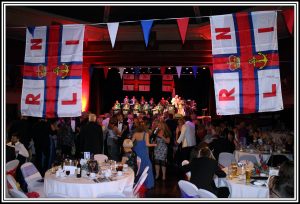 A series of events were held throughout the year to mark the 50th anniversary since an inshore lifeboat station was re-established at Porthcawl. Events included a station visit by HRH Princess Anne, a very successful formal celebratory ball in the Grand Pavilion, a barrel smuggling event as well as a sponsored walk and concerts etc. Locals and shops were encouraged to show their support by displaying special #PorthcawlRNLI50 window stickers. A commemorative 50th anniversary brochure was also produced.
A series of events were held throughout the year to mark the 50th anniversary since an inshore lifeboat station was re-established at Porthcawl. Events included a station visit by HRH Princess Anne, a very successful formal celebratory ball in the Grand Pavilion, a barrel smuggling event as well as a sponsored walk and concerts etc. Locals and shops were encouraged to show their support by displaying special #PorthcawlRNLI50 window stickers. A commemorative 50th anniversary brochure was also produced.
